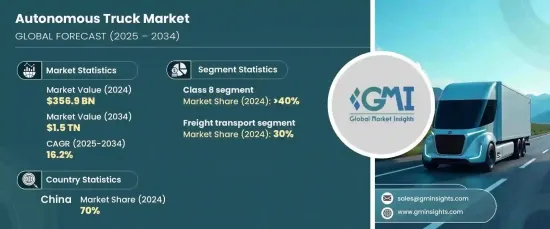
자율주행 트럭 세계 시장은 2024년에 3,569억 달러로 평가되었고, 2025년부터 2034년에 걸쳐 16.2%로 성장할 것으로 예상됩니다..
산업계가 효율 개선, 비용 절감, 안전성 향상을 목표로 하는 가운데, 자율주행 트럭은 급속히 중요한 솔루션이 되고 있습니다. 이 성장의 주요 원동력은 자율 주행 차량에 대응하기 위한 인프라 업그레이드에 세계 정부가 점점 더 주력하고 있다는 것입니다. 스마트 인프라에 대한 투자는 매우 중요하며 도로, 고속도로 및 기타 중요한 운송 네트워크가 이러한 최첨단 기술을 지원할 수 있음을 보장합니다. 진화하는 규제 프레임 워크와 첨단 기술의 조합은 자율 주행 트럭 운송에 유리한 환경을 조성하는 데 도움이 됩니다. 이 추세는 운전자 부족, 교통 체증, 높은 운영 비용 등의 문제에 대한 해결책을 제공하고 물류 및 운송 부문에 혁명을 가져올 것으로 기대됩니다.

트럭 클래스별로 세분화하면 시장에는 클래스 4, 클래스 5, 클래스 6, 클래스 7, 클래스 8 차량이 포함됩니다. 2024년에는 클래스 8 부문이 시장 점유율의 40%를 차지하고 2034년까지 6,000억 달러를 창출할 것으로 예상됩니다. 클래스 8 자율 주행 트럭은 운전 비용을 크게 줄일 수 있기 때문에 두드러집니다. 이러한 차량은 연료 효율을 최적화하고, 인간 운전자의 필요성을 제거함으로써 인건비를 절감하고, 유지 보수 작업을 간소화합니다. 또한 운행시간 제약 없이 24시간 365일 운행할 수 있어 생산성이 향상되고 생산량을 늘리면서 운행비용을 절감하고자 하는 기업에게 매력적인 선택이 됩니다.
| 시장 범위 | |
|---|---|
| 시작연도 | 2024년 |
| 예측연도 | 2025년-2034년 |
| 시작금액 | 3,569억 달러 |
| 예측 금액 | 1조 5,000억 달러 |
| CAGR | 16.2% |
시장은 용도별로 세분화되어 있으며 주요 분야에는 건설, 라스트 마일 배송, 화물 운송, 광업 등이 포함됩니다. 2024년에는 화물 운송이 시장의 30% 점유율을 차지했습니다. 전자상거래의 급속한 확대로 효율적이고 비용 효율적인 물류 솔루션에 대한 수요가 증가하고 있다는 것은 화물 운송에서 자율주행 트럭의 성장에 박차를 가하고 있습니다. 이러한 차량은 신뢰성이 높고, 빠르고, 경제적인 상품 이동 방법을 제공하며, 배송 과정에서의 속도와 신뢰성에 대한 요구 증가에 부응하고 있습니다. 기업이 물류 체인의 개선을 목표로 하는 가운데 자율주행 트럭은 솔루션의 필수적인 부분으로 부상하고 있습니다.
2024년 중국은 자율주행 트럭 시장을 독점했으며 총 점유율의 70%를 차지했습니다. 이 나라의 급속한 시장 성장은 정부의 강력한 지원과 첨단 규제 환경으로 인한 것입니다. 중국 정부는 보다 광범위한 '메이드 인 차이나 2025' 구상의 일환으로 자율주행차 기술의 개발과 전개를 적극 추진하고 있으며, AI와 스마트 수송 기술의 강화에 주력하고 있습니다. 이 전략적 방향은 자율주행 트럭의 성장을 지원할 뿐만 아니라 중국을 당분간 동 시장의 세계적 리더로 자리매김하는 것입니다.
The Global Autonomous Truck Market reached USD 356.9 billion in 2024 and is set to experience an impressive CAGR of 16.2% from 2025 to 2034. As industries seek to improve efficiency, reduce costs, and enhance safety, autonomous trucks are rapidly becoming a key solution. A major driving factor behind this growth is the increasing focus of governments worldwide on infrastructure upgrades to accommodate autonomous vehicles. Investments in smart infrastructure are pivotal, ensuring that roads, highways, and other critical transport networks can support these cutting-edge technologies. The combination of evolving regulatory frameworks and advanced technology is helping create a favorable environment for autonomous trucking. This trend is expected to revolutionize the logistics and transportation sectors, offering solutions to challenges such as driver shortages, traffic congestion, and high operational costs.

Segmented by truck class, the market includes Class 4, Class 5, Class 6, Class 7, and Class 8 vehicles. In 2024, the Class 8 segment accounted for a dominant 40% of the market share, expected to generate USD 600 billion by 2034. Class 8 autonomous trucks stand out due to their potential to drastically reduce operational expenses. These vehicles optimize fuel efficiency, reduce labor costs by eliminating the need for human drivers, and streamline maintenance practices. Furthermore, their ability to operate 24/7 without being constrained by service hour limitations enhances productivity, making them a compelling choice for businesses looking to cut down on operational costs while increasing output.
| Market Scope | |
|---|---|
| Start Year | 2024 |
| Forecast Year | 2025-2034 |
| Start Value | $356.9 Billion |
| Forecast Value | $1.5 Trillion |
| CAGR | 16.2% |
The market is also segmented by application, with key areas including construction, last-mile delivery, freight transport, mining, and others. In 2024, freight transport held a 30% share of the market. The growing demand for efficient and cost-effective logistics solutions, driven by the rapid expansion of e-commerce, is fueling the growth of autonomous trucks in freight transport. These vehicles offer a reliable, faster, and more economical method of moving goods, meeting the increasing need for speed and reliability in the delivery process. As businesses seek to improve their logistics chains, autonomous trucks are emerging as an essential part of the solution.
In 2024, China dominated the autonomous truck market, accounting for 70% of the total share. The country's rapid market growth is largely driven by strong governmental support and a progressive regulatory environment. The Chinese government is actively pushing for the development and deployment of autonomous vehicle technologies as part of its broader "Made in China 2025" initiative, which focuses on enhancing AI and smart transportation technologies. This strategic direction not only supports the growth of autonomous trucks but also positions China as a global leader in the market for the foreseeable future.